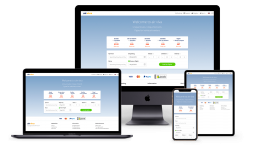Air Viva Case Study
Founded in Germany, Air Viva is an international travel agency with a strong presence in the African and Asian markets. Partnering with Forci has allowed Air Viva to grow and become a recognised brand by improving the overall user experience and further automating common tasks. This has led to an increase in the number of returning customers and a reduction in running costs.
1. Understanding the Air Viva business model
We’ve been working with Air Viva since 2013, providing support and bug fixes, and keeping the old existing project running while building a strong relationship based on trust and on understanding the business better. This allowed us to move a step further in 2015 and build Air Viva from scratch on a solid new foundation.
2. Planning the new Air Viva
The new project had to be highly flexible. The user interface had already been developed and sliced by a designer working closely with Air Viva.
The main challenges were:
- quick real-time API integration of over 10 partnering airlines
- finance and accounting that had to be built into the administration of the project
- a bookings management system that had to be easy for the client team to use
- an affiliates sub-system that works on different levels
- a translation system that would allow 20 translators to work simultaneously in real time, with a smooth UX and including metadata about the context of each element
3. Crafting
We chose Symfony as the new heart of the system because, in our opinion, it is the best enterprise-oriented PHP framework available. Symfony always encourages best practices and is extremely flexible and extendable. It has allowed us to swiftly integrate existing solutions to many common problems, giving us time to focus on the core business logic instead. Well-designed Symfony apps are also easy to maintain, which greatly improves stability and reduces costs.
The first stage of development took several months, during which time we laid the framework. The design was integrated, as were the first few airlines. The new project is also fully backwards compatible with legacy marketing and partner integrations, which continue operating to this day.
4. Continuous development and support
Symphony’s flexibility has allowed us to continuously add integrations with new airlines, developing several at a time without creating unnecessary complexity. Over time, as this process took place, all the legacy static flights were removed and everything became dynamic: no more paying for your booking only to realise the flight was already full.
Speaking of flexibility, in some markets certain airports do not have standard codes. But thanks to custom-developed interfaces for each integration that requires it, the system takes advantage of every single route, thus offering a rich set of flight choices. This completes the milestone ‘Air Viva 1.0’.
Moving forward, the main goal for ‘Air Viva 2.0’ was complete automation. Over time, each integration was upgraded to be able to book on its own, thus eliminating the need for 27/7 human oversight and maintenance of the project. This led to a reduction in maintenance costs to a fraction of what was previously required, allowing Air Viva to become even more competitive. The company also has affiliate and agency modules. These allow for complete transparency with its partners, where they can see exactly what is going on at any time. We have built a new API which coexists with the legacy one and allows deeper integration with new partners, while not obstructing existing ones from doing what they do best: sales.
5. Feedback
Over the past three years, thanks to its clever design and automation, Air Viva has grown almost 4 times. Today, we continue to constantly improve and extend its functionality.
